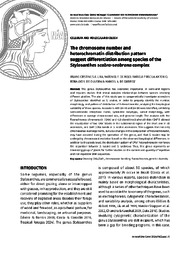The chromosome number and heterochromatin distribution pattern suggest differentiation among species of the Stylosanthes scabra-seabrana complex.
The chromosome number and heterochromatin distribution pattern suggest differentiation among species of the Stylosanthes scabra-seabrana complex.
Author(s): LIRA, I. C. S. A.; MELO, N. F. de; ANTONIO, R. P.; OLIVEIRA, R. S. de; QUEIROZ, M. A.
Summary: The genus Stylosanthes has economic importance in semi-arid regions and requires studies that reveal complex relationships between species involving of Stylosanthes identified as S. scabra, in order to properly identify the number, morphology, and pattern of distribution of heterochromatin, analyzing the karyological variability of these species. Accessions with 2n=40 and 2n=20 were identified, exhibiting semi-reticulate interphase nuclei, symmetric karyotype, varied morphology, with differences in average chromosomal size, and genome length. The analysis with the fluorochromes chromomycin (CMA) and 4’,6-diamidino-2-phenylindole (DAPI) allowed the visualization of two CMA+blocks in the subterminal region of the hort arm in all accessions, and DAPI+ /CMAbands in S. scabra accessions. This suggests that not only chromosomal rearrangements, but also changes in the composition of heterochromatin, may have occurred during the speciation of this genus, and that S. scabra may be undergoing chromosomal evolution based on the observed karyological differences. In addition to the ploidy level, the distribution pattern of CMA+ heterochromatin reinforces the separation between S. scabra and S. seabrana. Thus, this genus represents an interesting group of plants for further studies on the content and quantity of repetitive and non-repetitive DNA sequences.
Publication year: 2024
Types of publication: Journal article
Unit: Embrapa Semi-arid Region
Observation
Some of Embrapa's publications are published as ePub files. To read them, use or download one of the following free software options to your computer or mobile device. Android: Google Play Books; IOS: iBooks; Windows and Linux: Calibre.
Access other publications
Access the Agricultural Research Database (BDPA) to consult Embrapa's full library collection and records.
Visit Embrapa Bookstore to purchase books and other publications sold by Embrapa.

